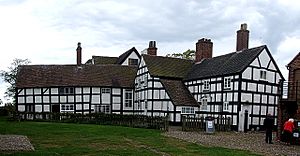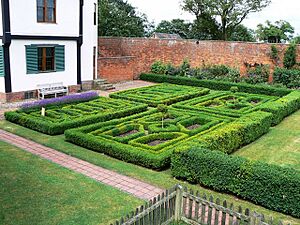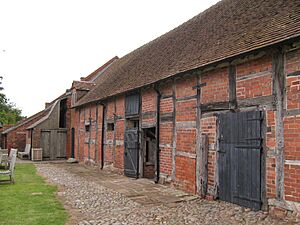Boscobel House facts for kids
Boscobel House is a very old and important building in Shropshire, England. It has been many things over the years, like a farm, a hunting lodge, and a holiday home. But it is most famous for helping King Charles II hide after a big battle in 1651. Today, English Heritage looks after it, so people can visit and learn about its amazing history.
Contents
Where is Boscobel House?
Boscobel House is located in Shropshire, a county in England. It's very close to the border with Staffordshire. Even though it's in Shropshire, it has a Stafford postcode. The house is near a small village called Bishops Wood. It's also just north of the M54 Motorway, making it easy to find.
History of Boscobel House
How Boscobel House Began
Boscobel House started as a timber-framed farmhouse in the 1500s. Around 1632, a landowner named John Giffard changed it into a hunting lodge. He added a large new part to the south, with a living room and bedrooms. These new rooms were perfect for a wealthy family to use.
John Giffard named his new hunting lodge Boscobel House. The name "Boscobel" comes from Italian words meaning "beautiful woods." This name made sense because the house was surrounded by thick forests back then.
Secret Hiding Places and a King's Escape
The Giffard family, who owned Boscobel, were Catholics. At that time, Catholics faced difficulties in England. Their house had secret hiding spots called "priest holes" to protect Catholic priests. This secret feature became very important in 1651.
In 1651, King Charles II was trying to escape after losing the Battle of Worcester. He was brought to Boscobel House. The Penderel family, who worked for the Giffards, helped him.
Charles II and a soldier named William Careless spent a whole day hiding in a nearby oak tree. From the tree, they could see soldiers searching for the King. Later, Charles II hid in one of Boscobel's secret priest holes. This amazing escape made Boscobel House famous in English history.
What Happened Next
After these exciting events, Boscobel House was passed down to the Fitzherbert family. They rented it out as a farm for many years. The Penderel family, who helped the King, were some of the tenants.
In 1812, the house was sold to the Evans family. They worked hard to restore the house and gardens. They also helped keep the story of Charles II's escape alive. In 1918, the house was sold again, and eventually, in 1984, English Heritage took over its care.
Boscobel House Today
Exploring the House
When you visit Boscobel House, you can see how it grew over time. The oldest part is the 16th-century farmhouse. A 19th-century farm building was added later. The main house, built by John Giffard, is also timber-framed.
Inside the 19th-century farm building, you'll find displays about Charles II's escape. The 16th-century farm building, called the "north range," shows how butter and cheese were made there long ago.
The main part of the house has a room called the Parlour. It has beautiful old wooden panels. There's also a small room called the Oratory, which might have been where the stairs were in the 1600s.
Upstairs, you'll find the Squire's Room. It has a small secret space that people think might be a priest hole. On the top floor, in the attic, there's another, more convincing priest hole. This is where King Charles II is believed to have spent a very uncomfortable night. He was very tall, about 6 feet 2 inches, but the hiding spot was only 4 feet high!
- The interior: a 19th-century re-creation
The Gardens and Grounds
North of the house is a large farmyard. It has old farm buildings and a 17th-century barn. This area is great for picnics and has displays of old farm tools.
To the south, you'll find the formal gardens. There's a beautiful parterre garden with low hedges. In one corner is a small hill called the Mount, where Charles II spent time reading.
Beyond the formal gardens, there's a kitchen garden with fruit trees. There's also a path lined with hazelnut trees.
The Royal Oak
The famous Royal Oak tree is about 150 yards southwest of the house. It is believed to be a direct descendant of the original tree where King Charles II hid. The tree is protected by iron railings and a wooden fence.
Three younger oak trees, grown from acorns of the Royal Oak's descendants, have been planted nearby:
- In 1897, a tree was planted to celebrate Queen Victoria's Diamond Jubilee.
- In 1951, another tree was planted to mark 300 years since Charles II's escape.
- In 2001, Prince Charles planted another oak sapling.
Gallery
- Grounds and displays
-
Display of butter-making equipment.
-
Water pump outside the 19th-century farm building.
-
The nut garden, an avenue of hazelnut trees.
-
The Royal Oak as it appeared in 2011.
Visiting Boscobel House
Boscobel House and its grounds are usually open from Wednesday to Sunday during the summer months (April to October). There is a charge to enter, but members of English Heritage can visit for free. Schools can also arrange free educational visits.
See also
- Grade II* listed buildings in Shropshire Council (A–G)
- Listed buildings in Boscobel



















